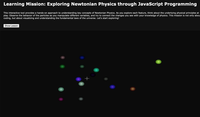Javascript module for Science Stage 5 : Newtons Laws and basic
-
Posted by Michael Kirch - Filed in Technology - #Science Education #Junior Science #Particle Physics # - 169 views
Particle Physics and JavaScript: A Pedagogical Integration for Enhanced Learning
IntroductionParticle physics, the branch of physics that studies the nature of particles constituting matter and radiation, has long been recognized as a fundamental yet complex subject within the scientific community. While traditional pedagogical methods have offered insights into this subject, they often remain abstract and detached from practical application. This paper explores the innovative integration of particle physics with JavaScript, a widely used programming language, as a means to enhance the educational experience and provide a more tangible understanding of complex concepts.
1. Interactive Learning Environment: A New Pedagogical Paradigm
Enhanced Engagement: The interactive platform allows students to engage with the subject matter through real-time experimentation, offering immediate visual feedback.
Promotion of Experimental Inquiry: This approach fosters an environment where students are encouraged to manipulate variables and apply different formulas, cultivating a deeper understanding through hands-on learning.
Immediate Feedback and Understanding: The real-time visual representation of particle behavior provides an intuitive connection between mathematical expressions and physical phenomena.
2. Application of Mathematical Principles to Real-World Physics
Bridging the Gap Between Theory and Practice: The application of mathematical equations through coding provides a tangible connection between abstract mathematical concepts and real-world physics.
Enhanced Physical Understanding: The visualization of particle behavior under various forces offers a comprehensive insight into the underlying principles of physics.
Interdisciplinary Integration: The confluence of mathematics, physics, and computer science provides a multifaceted educational experience, enhancing comprehension across multiple domains.
3. Democratization of Physics Education Through Technology
Increased Accessibility: Utilizing JavaScript, a language supported across various platforms, broadens the reach of educational content, providing accessibility without the need for specialized tools.
Customization and Adaptation: The flexibility of JavaScript enables educators to tailor lessons to the specific needs and levels of individual students, fostering a more personalized learning experience.
Community Collaboration: The extensive support and resources available within the JavaScript community further enhance the educational content, providing additional avenues for learning and collaboration.
4. Real-World Applications and Professional Development
Development of Marketable Skills: The integration of JavaScript into physics education imparts valuable skills that are transferable to various professional fields, including engineering, research, and technology.
Fostering Innovation and Creativity: This approach encourages innovative thinking, allowing students to explore novel solutions and ideas, thus contributing to the field of physics.
ConclusionThe synthesis of particle physics with JavaScript represents a significant advancement in the pedagogical approach to physics education. By facilitating hands-on learning, bridging the theoretical and practical divide, and fostering a more accessible and customized learning environment, this integration offers a robust and engaging method for understanding complex scientific concepts.
This paper posits that the intersection of physics and programming not only enhances the educational experience but also aligns with the contemporary needs of students and professionals alike. The implications for educators are profound, suggesting a shift towards an interdisciplinary and technologically integrated curriculum that resonates with the evolving demands of the academic and professional landscape.
In the context of modern education, where the integration of technology is becoming increasingly vital, this approach provides a compelling and academically rigorous path towards a more comprehensive and accessible understanding of particle physics. The innovative application of JavaScript in physics education heralds a new era of interactive and dynamic learning, with the potential to reshape the future of physics education.
